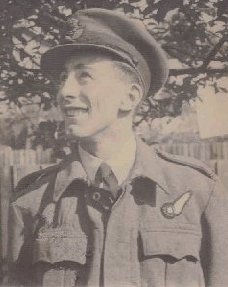The Airman's StoryDouglas JenningsDouglas Jennings was 19 years old when he received his RAF call-up papers in late 1941. He was accepted for immediate service by the Selection Board and told to report for duty in February 1942. After completing his preliminary training in England, Leading Aircraftman Douglas Jennings was given the aircrew category of 'Air Bomber' and posted overseas to South Africa for some thorough and rigorous training. Back in England and now promoted to a commissioned rank, Doug was sent off for yet more training and completed several specialist courses before finally "crewing up" in late summer of 1943. The young crews would now train together, initially in Wellington Aeroplanes. The crews for these aircraft consisted of a Pilot, a Navigator, an Air Bomber, a Wireless Operator and a Rear Gunner. I was amazed to learn how the crews were formed: the system was very simple - they all milled around and chose each other! (15 of each category at a time). That was how Doug first met the other members of the five-man Wellington crew: Welshman Guilyn (William) Guy (Pilot), Victor Spalding (Navigator), Grenville Hyde (Wireless Operator) and Eric Raffles (Rear Gunner). At last, after a final few weeks of conversion training in old Stirling and Lancaster Bombers, the crew, now at full strength with the addition of Joe Hatter (Flight Engineer) and Canadian Al Applegarth (Mid Upper Gunner), were posted to No. 57 Squadron at East Kirkby, Lincolnshire. It was now April 1944. The Squadron's Lancasters were equipped with all the latest navigational aids. They were ready for their first night operation.  On the night of 21st June 1944, Lancaster III, LM580 DX-L, carrying Doug Jennings and his fellow crew members, took off at 23:07 hours from East Kirkby Airfield. The crew of seven had already completed 17 operations without so much as a scratch or a dent on their new aeroplane. Their target was an oil plant in Wesseling, Germany. However, they never had the opportunity to drop their bomb load as the Lancaster was hit by Flak¹ (anti-aircraft fire from the ground) on the outbound journey. A shell had pierced the starboard wing and set it on fire. Doug's pilot, P/O Guilyn 'Ginger' Guy, quickly gave the order to, "Put on parachutes!", and six baled out of the burning aircraft. ¹ N.B. Not a "night-fighter" as published in the book, "RAF Bomber Command Losses 1944". Doug is most adamant about this and has stated that night-fighter attacks usually The Lancaster Bomber fell at As-en-Campine (Limburg Province) some 8km north-east of Genk, in Belgium. Sadly, Doug learnt later that 'Ginger' Guy did not make it - he is buried in a small Communal Cemetery at As-en-Campine, near the crew of a 214 Squadron Wellington which had crashed in July 1941. "When I first met Madame Janssen, I had enquired whether she was aware of any other aircrew in the area of Eisden, and she had told me that one body was in the local Church. She could not get a name, because the Germans were on guard, but the description she gave, especially quoting the red hair, sounded like our pilot. There were many crashed aircraft at the time, and I had been hoping that Ginger had survived ..." Doug was helped by a number of very brave people, my aunt was just one person in the chain. "..our destination was a small general shop in Eisden about 3 miles away, run by Monsieur and Madame Janssen. She was part of the official escape route and had already passed several airmen like myself down the line, but ... Madam Janssen told us that her husband had been arrested. The Gestapo had taken him for questioning because someone in the village had been firing off revolvers during the night... That put paid to my staying on the premises, but Madame Janssen had arranged for me to stay at another place in Eisden. (She spoke very good English and told me that she had been brought up in London and her brother still lived there)... One benefit of being in official contact with the escape line was the false identity card I now carried, and supplied by Madame Janssen; it wasn't perfect, but it was better than nothing." My aunt brought Doug to Monsieur and Madame Duchene, who owned the local jewellery shop. Germans knocked on the door all the time bringing watches for repair but took little notice of the jeweller's new assistant! Later, my aunt brought two more evaders to the Duchene's, an American, Charles (Chuck) Haupt, and Albert Keveren, an RAF Air Bomber. Doug left Eisden, a day or so after Chuck and Albert, on the 10th August 1944 – his 22nd birthday. Please note that all extracts in blue italic type on this and the following page are from
"Jump or Die", a recently published book* by Flight Lieutenant Douglas Jennings.
* See book details and my comments on page two. RAF crests at top of page courtesy RAF Marham
Copyright © 2003-2005 Tessa Steer / Douglas Jennings - All Rights Reserved Worldwide
|
||||||||||||